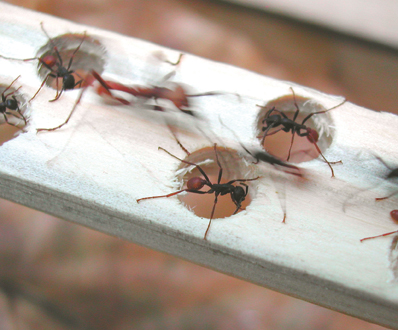Pothole repair, insect-style
Army ants forced to travel on a narrow wooden strip throw themselves into holes and allow fellow travelers to race over them.
Share this:
- Share via email (Opens in new window) Email
- Click to share on Facebook (Opens in new window) Facebook
- Click to share on X (Opens in new window) X
- Click to share on Pinterest (Opens in new window) Pinterest
- Click to share on Reddit (Opens in new window) Reddit
- Share to Google Classroom (Opens in new window) Google Classroom
- Click to print (Opens in new window) Print
By Emily Sohn
When our roads and highways become full of potholes, construction workers use concrete to repair them. Ants have their own road-repair techniques. They use their bodies to temporarily plug the holes.
 |
|
Army ants forced to travel on a narrow wooden strip throw themselves into holes and allow fellow travelers to race over them.
|
| Scott Powell |
By allowing other ants to walk over them, a new study finds, the pothole-repair volunteers help keep the whole colony well fed. Without these instant road repairs, a colony’s daily food catch can drop by up to 30 percent, says Scott Powell of Brazil’s Federal University of Uberlândia.
Researchers from Brazil and England studied a type of army ant that hunts for food during the day. A single colony of these ants (called Eciton burchellii) may include up to 700,000 members.
At night, the ants cling to each other, forming a huge ball that dangles from the side of a tree or other object. At dawn, up to 200,000 of the colony members swarm out of the ball to hunt for food. “The pitter-patter of millions of little feet sounds a lot like rain,” says Powell.
The hunters create a two-way trail that is between 3 and 12 ants wide. When the front lines encounter spiders, other species of ants, and even scorpions, the army ants group up, grab the prey, inject it with venom, and pull it apart. They carry the remains back to the colony, where other workers take care of the young.
It’s a busy life for these foragers, and any delay in traffic can have a major effect on the day’s food catch. Holes in the road are a problem for ants, just as they are for people.
To see how such holes affect the ants, researchers drilled holes into strips of wood. They placed these strips in the ants’ main trail.
When the first ant reached a hole, the scientists observed, the insect stretched across it and rocked back and forth. It seemed as if the ant was measuring the hole’s size. And indeed it was. If its body fit the hole, the ant anchored itself inside the hole and let its colony mates run over it.
Once the traffic dwindled, the hole-plugging ant popped out of the hole and continued on its way. If a big ant was too big for a small hole, it kept going, leaving the hole for a smaller ant to fill.
The hole pluggers perform a valuable service for their colony. Without those temporary fixes, traffic would slow down on rough stretches of trail. While carrying food, large ants normally run at a speed of 8 centimeters (3.1 inches) per second—if all potholes are fixed. Otherwise, they slow to the speed of small ants—about 6 cm (2.4 inches) per second.
Meanwhile, the rest of the colony is waiting for lunch.







